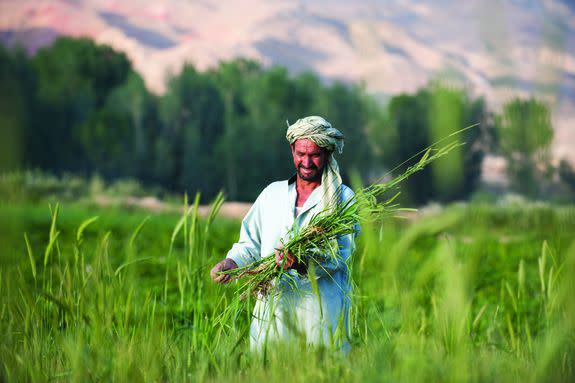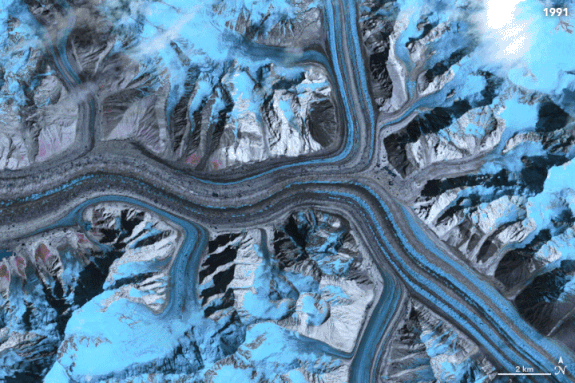Don’t forget about the colossal Himalayan glaciers. They’re rapidly vanishing, too.

The Himalayas pierce the sky. But they've been overshadowed.
The accelerated melting in the Arctic — the fastest warming region on Earth — and the Antarctic — home to the largest ice sheets on the planet — certainly demand widespread scientific and media attention. Yet beyond the continually grim news from the north and south poles is the melting of the "third pole," known as the Hindu Kush Himalaya region. Spreading over 2,000 miles across eight nations (from Afghanistan to Myanmar), these mountainous lands are home to the third-largest stores of ice on the planet and provide water to hundreds of millions of people.
A new report written by 210 scientists emphasizes the dramatic melting there this century. The International Center for Integrated Mountain Development (ICIMOD) — a Nepal-based intergovernmental research organization — released the 638-page report on Monday, concluding that these glaciers are expected to lose immense amounts of ice as the mountains warm.
Under the most optimistic conditions, the report found that over a third of the ice will vanish by the century's end. But under more extreme climate scenarios — wherein global climate efforts fail — two-thirds of these mighty glaciers could disappear, with overall ice losses of a whopping 90 percent.
"Glacier-wise, it's not a great story," Joseph Shea, one of the report's lead authors and an assistant professor of environmental geomatics at the University of Northern British Columbia, said in an interview.
"You go up [to the glaciers] and see that the signs of recent loss are pretty substantial," said Shea, who spent four years living in Nepal, watching firsthand as the ice thinned and, in some cases, vanished.

Image: Alex Treadway/ICIMOD
"The punchline is the glaciers are receding in response to changes in temperature and precipitation — they’re wasting away," Alex Gardner, a NASA glaciologist who had no role in the report, said in an interview.
Shea emphasized the importance of reining in heat-trapping carbon emissions ("Every kilogram we don’t emit helps"), but noted that the melting will still be considerable this century. The atmosphere is already loaded with carbon dioxide, a potent greenhouse gas that is at its highest levels in some 15 million years.
Under the most ambitious scenario of limiting global warming to just 1.5 degrees Celsius (or 2.7 Fahrenheit) above pre-industrial revolution levels in this century, the report finds that the Hindu Kush Himalaya region will lose one in three of its glaciers.
But this scenario is no longer realistic.
"We're not gonna hit 1.5 C," acknowledged Shea. "We’re gonna blow by that."
The reasons are simple. The four biggest carbon emitters — China, the U.S., India, and EU — haven't yet decreased their emissions in a sustained, impactful way. Last year, carbon emissions in the U.S. popped up.
SEE ALSO: It's damn cold, but heat records in the U.S. still dominate
And even with 2 degrees Celsius of warming — which is also a hugely ambitious climate target — around half of the Hindu Kush Himalaya region's glaciers are expected to vanish by century's end, the report concluded.
While these are enormous numbers, they're not too shocking. In fact, they're consistent with mainstream climate science.
"There are no surprises," Ted Scambos, a senior research scientist at the National Snow and Ice Data Center who had no involvement in the report, said in an interview. "It's happening everywhere."
"I don’t know of any glaciated range that isn’t showing a loss of ice," Scambos added.
"What the global signal tells us is everything is in a state of rapid retreat," added Gardner.

Image: Alex Treadway/ ICIMOD
The crux of the problem is local warming on the mountains. The line that separates where it's cold enough to make snow, called the "equilibrium line," keeps rising higher, which means less snow and more melting.
"That line pushes up and you expose a bunch of ice to melting," said Shea.
Thinning glaciers pose momentous problems for the millions of people living below.
"It's not just a symbol of climate change," said Gardner. "These glaciers will have meaningful consequences for the population."
Glaciers act like batteries, he said. "They don't make water, they store it and release it." During warmer and dryer times, people and farmers depend on these natural batteries to release water, especially when water becomes a scarce, critical resource.
"They are incredibly valuable downstream resources," said Gardner.

Image: nasa
But, sometimes, there's too much water. Less snow means more rain and a quicker run-off into some of the planet's largest rivers, like the Ganges and Yellow. This translates into surges of water, extreme flooding, and crop devastation, the report stated.
In the Himalayas and around the globe, the glacier narrative is clear. But just how much they'll ultimately thin and recede above the clouds is contingent upon human-generated carbon emissions. Already, the planet is the warmest it's been in 120,000 years, and ancient glaciers are a visible victim.
"When you get up there [to the glaciers] and visually see it, it's stunning," said Shea.
"How long have they existed there, and how quickly have we got rid of them?" mused Gardner.
WATCH: Ever wonder how the universe might end?


